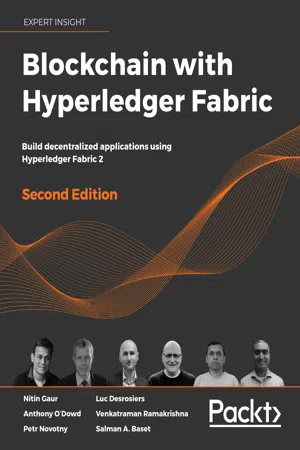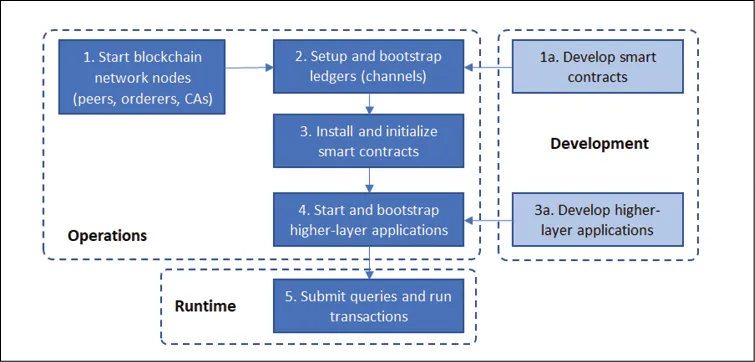
Blockchain with Hyperledger Fabric
Build decentralized applications using Hyperledger Fabric 2, 2nd Edition
Nitin Gaur, Anthony O'Dowd, Petr Novotny, Luc Desrosiers, Venkatraman Ramakrishna, Salman Baset
- 756 pages
- English
- ePUB (adapté aux mobiles)
- Disponible sur iOS et Android
Blockchain with Hyperledger Fabric
Build decentralized applications using Hyperledger Fabric 2, 2nd Edition
Nitin Gaur, Anthony O'Dowd, Petr Novotny, Luc Desrosiers, Venkatraman Ramakrishna, Salman Baset
À propos de ce livre
Learn to develop blockchain-based distributed ledgers and deploy a Hyperledger Fabric network with concrete exercises and examples
Key Features
- Updated with the latest features and additions that come with Hyperledger Fabric 2
- Write your own smart contracts and services using Java and JavaScript on a Hyperledger Fabric network
- Dive into real-world blockchain challenges such as integration and scalability
Book Description
Blockchain with Hyperledger Fabric - Second Edition is a refreshed and extended version of the successful book on practical Hyperledger Fabric blockchain development. This edition includes many new chapters, alongside comprehensive updates and additions to the existing ones. Entirely reworked for Hyperledger Fabric version 2, this edition will bring you right up to date with the latest in blockchain. Using a real-world Trade Finance and Logistics example, with working code available on GitHub, you'll really understand both how and why Hyperledger Fabric can be used to maximum effect. This book is your comprehensive guide and reference to explore and build blockchain networks using Hyperledger Fabric version 2.
This edition of the book begins by outlining the evolution of blockchain, including an overview of relevant blockchain technologies. Starting from first principles, you'll learn how to design and operate a permissioned blockchain network based on Hyperledger Fabric version 2. You will learn how to configure the main architectural components of a permissioned blockchain network including Peers, Orderers, Certificate Authorities, Channels, and Policies. You'll then learn how to design, develop, package, and deploy smart contracts, and how they are subsequently used by applications. This edition also contains chapters on DevOps, blockchain governance, and security, making this your go-to book for Hyperledger Fabric version 2.
What you will learn
- Discover why blockchain is a technology and business game changer
- Set up blockchain networks using Hyperledger Fabric version 2
- Understand how to create decentralized applications
- Learn how to integrate blockchains with existing systems
- Write smart contracts and services quickly with Hyperledger Fabric and Visual Studio Code
- Design transaction models and smart contracts with Java, JavaScript, TypeScript, and Golang
- Deploy REST gateways to access smart contracts and understand how wallets maintain user identities for access control
- Maintain, monitor, and govern your blockchain solutions
Who this book is for
This book is designed in such a way that professionals from different areas including business leaders, technology leaders, blockchain application developers, and even beginners can benefit from it.
Foire aux questions
Informations
9
Network Operation and Distributed Application Building
- In Chapter 4, Setting the Stage with a Business Scenario, we configured and ran a barebones trade network from a set of specifications
- In Chapter 5, Designing Smart Contract Transactions and Ledger Data Structure, we built the core of a blockchain application in the form of a set of smart contracts that directly read and manipulate the ledgers that are the systems-of-record for your network
- We will learn how to build and operate a distributed Fabric application for the business entities that participate in our trade scenario:
- We will recap the Hyperledger Fabric ledger setup and transaction pipelines
- We will show how each step is performed using code and configuration samples
- At the end of this process, you will understand how to:
- Bootstrap network ledgers
- Install contracts
- Engineer applications as web services that can be exercised by users through commands on a terminal or from a web browser
- We will learn how to build a production-grade ordering service that generates transaction blocks by consensus of a cluster of nodes running the Raft protocol
Stages in a Fabric network's life cycle
- Network setup and bootstrapping activities are classified into operations, which is the responsibility of network operators designated by their respective organizations or by the consortium. Operators will also typically oversee DevOps.
- Development, which involves designing, writing, and testing application code, can occur before or concurrently with operations. The developers responsible for this are typically distinct from operators and do not need to know operational details, though they need to know the organizational and channel structure to write proper code.
- Finally, the exercising of the applications' business logic is classified into runtime activities, and this is done by members and clients of the enterprises that belong to the network consortium.
